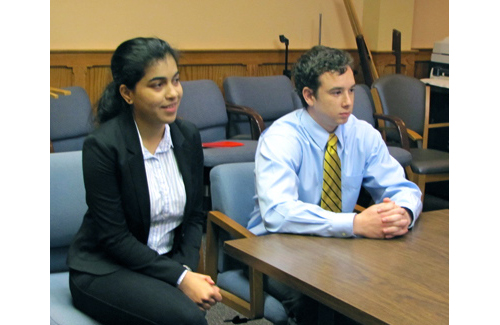SBU presentation warms town up to mixed-use at EPCAL

Riverhead Town is in contract to pay professional consultants about $500,000 for a land-use study land at Enterprise Park at Calverton.
But a study done for free by three Stony Brook University students may have the biggest impact in terms of convincing the town to allow mixed-use residential development at EPCAL — something town officials have opposed in the past.
During Thursday’s Town Board work session, SBU’s School of Business students Justin Kline and Neha Shethia gave a presentation showing how a combination of residential and commercial properties could make an industrial park at EPCAL successful.
“If new businesses move out to the area, then they will need workers who will need affordable housing,” the students’ report states. “[Riverhead] is not the most easily accessible place to travel to in the event that industrial parks are built there.”
Ms. Shethia added during the presentation: “It’s not easy coming to Riverhead, even for us, coming from Stony Brook.”
Councilman John Dunleavy said he thinks mixed-use development is a “pretty good idea” at EPCAL because of the current condition of the roads.
“Our roads can’t sustain more traffic,” he said. “We have to have somebody living there to work there.”
The students are part of professor Rafael Aquayo’s “industry project” and worked on the study with their classmate Mao Du for nearly two years. Their assignment was to transform EPCAL in a way that would attract high-paying jobs to the area, Mr. Aquayo said.
Supervisor Sean Walter said although he’s been one of the biggest opponents of residential uses at EPCAL, he’s now starting to change his stance in part because of the students’ presentation.
“The town is now moving toward mixed use, we should have listened,” Mr. Walter said after Thursday’s work session. “It took three 22-year-old college kids to convince us.”
The town hired VHB Engineering for $462,000 to conduct an EPCAL study. It began in February 2011 and was expected to be completed in two years. It is taking longer than expected to complete because of traffic and redevelopment concerns, the supervisor said.
“When we hit a certain number of car trips per hour, development at EPCAL will probably be halted — maybe temporarily, maybe permanently — until other infrastructure improvements can be built and further studies are done,” Mr. Walter said.
VHB is responsible for doing an environmental impact study, for recommending zoning or land use changes, and they also will draw up a 50-lot subdivision map for EPCAL.
Mr. Walter has said their studies will be done this year, although the expected completion date has been pushed back many times.
Engineers have determined there isn’t enough road surface at and around EPCAL to handle the maximum build out of the property — findings the students also found.
Mixed-use development — a recommendation in the EPCAL marketing study done for the town in 2011 by RKG Associates — was one of the points of disagreement between the town and Rechler Equity Partners in 2011, when the town backed out of a contract to sell 300 acres to Rechler because the developer wanted to add a residential component to the industrial park.
In addition, VHB Engineering has also recommend mixed-use development at EPCAL, calling for a combination of residential, business and light industrial uses.
However, the report also calls for a combination of residential and retail uses. The town has, thus far, opposed allowing retail uses at EPCAL.
The students also recommended use of the federal EB-5 visa program in redeveloping EPCAL. That program provides a method of obtaining a Green Card for foreign nationals who invest money in the United States, so long as they invest at least $1 million and create or preserve at least 10 jobs.
Mr. Walter said the EB-5 program is interesting because foreign investors tend to invest larger amounts than American companies in areas like infrastructure.
“We’ve got a very big job ahead of us and I’m just stunned at what you guys did,” he told the students. “You put your finger right on the pulse of what the consultants that get paid a lot of money have been telling us.”








